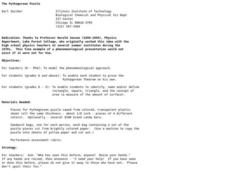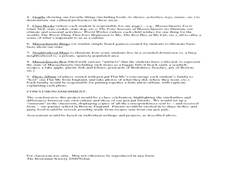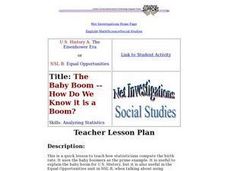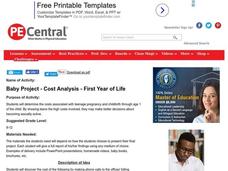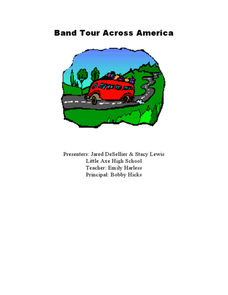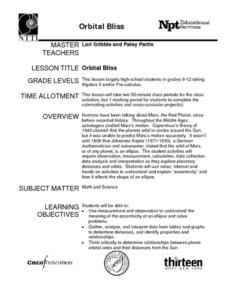Curated OER
Does Your Field Measure Up
Students measure angles using a plane table kit. In this geometry lesson, students use trigonometric identities to find the values of the length of a football field.
Curated OER
The Pythagorean Puzzle
An engaging hands-on activity is presented. Learners of all ages are addressed in thie unique plan. K-5 learners identify, name, and define a rectangle, square, triangle, and the concept of area. Older learners prove the Pythagorean...
Curated OER
My Credit Card Plan
Remember all those credit card tables lined up on your college campus? So alluring and dangerous, if you don't know what you're doing. Prepare your pre-college attendees for life by offering a lesson on credit management. They discuss...
Curated OER
Water and Land 207
Students examine maps of different projections, mathematically calculate distortions, and note the advantages and disadvantages of each map. They study the different maps and transfer the map to graph paper.
Curated OER
SRDES-Webquest Project
High schoolers create a webquest on any topic that they would like. Before students begin their webquest project they visit a webquest and select the Social Studies; they then choose "Blmorhea-Oasis in the Desert." They work through the...
Curated OER
Fraction Jeopardy
Students investigate basic concept of fractions by using a version of the game Jeopardy. The game is played using a television monitor or projector for the integration of technology. The lesson is highly engaging and can hold student...
Curated OER
Exploring Functions with Calculus and Dynamic Software
Calculus can be project-based and inquiry-centered by using dynamic software.
Curated OER
Out of Old England in the 1630s-Flat Me Project
Students write letters to penpals. In this geography/literacy lesson plan, students become penpals with a classroom in England to learn about customs and society across the ocean. Flat Stanley by Will Holton is read aloud, and students...
Curated OER
Super Hero High
Students define the characteristics of a hero by creating their own fictional superhero. In this film making activity, students write the background of a superhero character and storyboard scenes from a movie they would like to make....
Curated OER
Highs and Lows
Learners use email to chart weather patterns and then graph their findings. In this weather patterns lesson, students chart their weather for a week at the school. Learners then use email to find temperatures at a variety of locations....
Curated OER
Math: Checking Scale Drawings for Accuracy
Students critique their own drawings for accuracy and make constructive suggestions prior to reworking them. They discover how scale in maps and drawing relate to relative size and distance. In addition, students comprehend the...
Curated OER
Climate and Periodic Functions: Science & Math Integration
Students complete a lab that introduce the scientific concept of climate on Earth. Following the lab, they complete further research on climate. Using average monthly temperatures students construct a mathematical model and analyze the...
Curated OER
The Baby Boom -- How Do We Know it is a Boom?
Students examine graphs of three statistics and use basic math to compute their own. They evaluate the implications of manipulating data and whether statistics are appropriate for creating policy.
Curated OER
R-Project
Students analyze the outcome of a scientific experiment using free downloadable software. They collect experimental data to use statistical software to determine if the observations are likely due to the treatment or random chance.
Curated OER
Baby Project - Cost Analysis - First Year of Life
Students determine the costs associated with teenage pregnancy and childbirth through the child's first year. They consider prenatal and postnatal care for mother and child, clothing, food, equipment, childcare, etc. They present their...
Curated OER
Stressed to the Breaking Point
Young scholars explore the relationship between the amount of weight that can be supported by a spaghetti bridge, the thickness of the bridge, and the length of the bridge to determine the algebraic equation that best represents that...
Curated OER
Area Under A Curve
Calculus learners use the derivative and integral to solve problems involving areas. They calculate the area under a curve as they follow a robot off road making different curves along the drive, using Riemann Sums and Trapezoidal rules...
Curated OER
Band Tour Across America
Students plan the trip of a band across America. In this money planning lesson, students create a budget for the band using excel basic functions. They manage the band and its budget and relate the tour to future budgeting needs of the...
Mathematics Vision Project
Module 6: Trigonometric Functions
Create trigonometric functions from circles. The first lesson of the module begins by finding coordinates along a circular path created by a Ferris Wheel. As the lessons progress, pupils graph trigonometric functions and relate them to...
Alabama Learning Exchange
Ice Cream Sundae Survey
Young scholars analyze data through graphs. They will complete a class survey on ice cream sundaes and tally and graph the responses. They then analyze the information from the class graph.
Curated OER
Funerals and Burial Rites
Ninth graders research burial practices that originated in West Africa and then migrated to the South Carolina and Ohio. They compare and contrast burial practices in both places. As students collect information and data, they organize...
Curated OER
Graphs and Data
Students investigate poverty using graphs. In this algebra lesson, students collect data on the effects of poverty and use different rules to analyze the data. They graph and use the trapezoid rule to interpret the data.
Curated OER
Orbital Bliss
Most young mathematicians are aware that the planets don’t orbit the sun in a circle but rather as an ellipse, but have never studied this interesting feature. This resource looks at the planetary orbits in more detail and helps learners...
Curated OER
Deriving the Formula For the Area of a Circle
Young scholars derive the formula for the area of a circle. They form a rectangle by partitioning a circle using construction paper and scissors.



